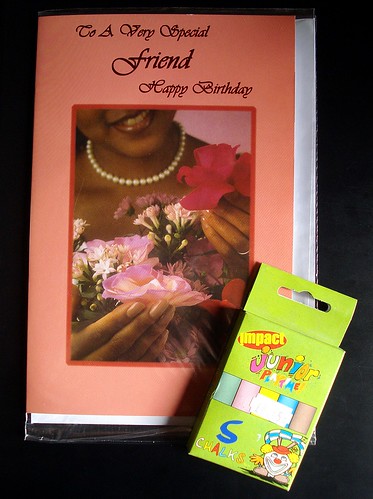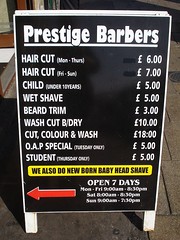When I made my first survey of central Croydon retail in late 2011, I was very puzzled by the curious numbering of 24–26 London Road.[1] Despite the double number, and the lack of a gap between the building and its neighbours at number 22 and number 28, this is just a single shopfront housing a newsagents and convenience store known as Early Till Late.[2]
c.1899: Construction of the building
Numbers 22 and 24–26 London Road were constructed at the same time, around 1899,[3] replacing a previous building and filling in a gap between Oakfield Terrace (now numbers 28–42 London Road) and the older properties closer to West Croydon Station. They were built to the same height as Oakfield Terrace but in quite a different style, with a decorative curve detail on the roof profile, larger windows on the second floor, and protruding bay windows on the first floor.
A rather peculiar street number
The issue of numbering is even more perplexing given that the whole of London Road was renumbered in 1927. Prior to this date, the property was numbered 8a, which makes sense as it came between numbers 8 and 10. The fact that it and its neighbour were numbered 8 and 8a rather than 8 and 10 also makes sense — these were built as a pair to replace a single older building, and at this point numbers 6 downwards and 10 upwards already existed, so short of renumbering the entire road there was nothing for it but to assign numbers 8 and 8a to the new properties.
However, surely the 1927 renumbering would have been an ideal opportunity to make sure that each property had exactly one street number! Perhaps the new excess of numbers between 22 and 28 was some kind of overreaction to the years where 8 and 8a had to share a number.
1900s–1920s: M Harland and the Misses Kingsland
In any case, the first occupants of the newly-constructed building were in by 1900, and knew it as 8a London Road. These persons were M Harland, watchmaker and jeweller, and the Misses Kingsland, who ran a servants' registry office and also traded as antiques dealers. I don’t know how the two parties shared the property; street directories simply list them at the same address.[4] As well as arriving together, M Harland and the Misses Kingsland also left together; their last appearance in street directories is in Ward’s 1927.[5]
I’ve mentioned the Misses Kingsland previously; they were the daughters of Mary Ann Kingsland, whose servants’ registry office, dyeing and cleaning agency, and antiques dealership was at 18 London Road (in modern numbering) from around 1869 until her death in 1897. Charlotte Emily and Frances Hannah continued their mother’s business at 18 London Road for a couple of years before moving a few doors along to the property which today is numbered 24–26.
M Harland, despite the lack of title in Ward’s street directory entries, appears to have also been a “Miss” — she’s given this title in Kelly’s 1927 directory. However, I haven’t been able to find her in the 1901 or 1911 censuses, so I can’t confirm her gender. She may also have been the “Harland, jeweller” listed at 75 London Road[6] in Ward’s directories from 1929 to 1939, but given the lack of initial in Ward’s directories and her absence from phone books,[7] I can’t be sure.
1920s–1930s: Herbert Clifton, John Maxwell, and Burlington Ltd
Next to move in to 24–26 London Road — which finally had that numbering by then — was a succession of tailors and outfitters. The first of these was Herbert Clifton, who arrived around 1928. By 1932, he had been replaced by John Maxwell, and by 1934, John Maxwell had been replaced in turn by Burlington Ltd.[8]
I’m unsure how long Burlington remained on London Road. The last documentary evidence of it is in Ward’s 1939 directory, but as comprehensive street directories were no longer published after this edition (aside from a couple in the mid-1950s), it could have been there throughout the 1940s as well.
1940s–1980s: The Cavendish Café and Cavendish Tobacconists Ltd
By 1949, the premises were home to the Cavendish Café, which remained in place until the late 1970s.[9]
By 1974, the Cavenddish was selling tobacco and confectionery as well,[10] and from 1978, it was listed in phone books not as a café, but as a “cut-price tobacconists”, though still under the name “Cavendish”.[11] By 1980, Cavendish Tobacconists Ltd had two branches on Church Street as well as their head office on London Road (which had also begun selling newspapers); but by 1984 the London Road property was vacant and the Church Street branches had also vanished from phone books.[12]
1980s–present: Early Till Late
Next came another tobacconists/confectioners called Court Park.[13] By around 1989, however, this had become Early Till Late, a full-scale convenience store selling groceries, newspapers, sweets, drinks, snacks, tobacco products, and alcohol.[14]
Aside from a minor name change from “Early Till Late” to “Early To Late” (and back again!), and a few redecorations of the frontage, the shop has since remained essentially the same right up to the present day. Its longest-serving employee (Mr Moorthy) has been working there for over 20 years.
Today, Early Till Late is open seven days a week (6:30am–10pm Mon–Sat and 7am-6pm Sun[15]), selling groceries ranging from packaged naans to tins of sardines; stationery items ranging from notebooks to packing tape; household goods such as washing powder and pet food; newspapers and magazines; sweets and chocolate; tobacco products; and a wide range of alcoholic and non-alcoholic drinks.
Thanks to: Brian Gittings; Mr Moorthy of Early Till Late; all at the Croydon Local Studies Library; and my beta-readers Flash and Shuri. Census data and phone books consulted via Ancestry.co.uk.
Footnotes and references
- I didn’t have local history in mind at this point; the purpose of this survey was to gather data for the Completists’ Guide to Croydon, a website I made which lists all retail shops and shopfront businesses within central Croydon. More about the motivation and maintenance of the Completists’ Guide can be found in the site FAQ.
- As of September 2013, the Royal Mail postcode finder states that the address of Early Till Late is 24-26 London Road, CROYDON, CR0 2TA. There was no number on the frontage when I first photographed the property in December 2011, but the new frontage installed in 2012 shows the number 24–26.
- See my article on 22 London Road.
- Information from Ward’s street directories. Ward’s 1901 also lists a Mrs Slimmon, “certificated nurse”, though she has vanished by the next year’s edition.
- Coincidentally, this is also the last appearance of the address 8a London Road, as by the next edition the renumbering had taken place. This does slightly weaken the evidence that 8a was renumbered to 24–26, since my usual way of determining renumberings is to follow individual businesses down the years, but I feel there’s enough evidence from the businesses on either side. Betty the milliner/costumier and Pioneer Teeth Institute are both numbered as 6–8 in Ward’s 1927 and as 20–22 and 22a respectively in Ward’s 1928; while John Joyce, North Park Dairy, is numbered as 10 in Ward’s 1927 and 28 in Ward’s 1928. The businesses at 8a are consistently placed between those at 8 and 10, so 8a must have been to the north of 8 rather than the south (I consider it unlikely that 8a was on the first floor of 8, since that would mean that the building now numbered 24–26 was vacant for two and a half decades until Herbert Clifton moved in).
- That’s 75 London Road in both contemporary and current numbering; street numbers on this part of London Road have remained stable since the 1927 renumbering.
- I checked the September 1929, March 1930, September 1930, February 1931, August 1931, February 1932, August 1932, February 1938, August 1938, February 1939, and August 1939 London phone books (which despite the name, and the fact that they predate Croydon’s status as a London borough, all cover addresses in Croydon too). None of them list anyone called Harland anywhere on London Road. (Note that I didn’t look at phone books between 1933 and 1937, because I felt it unlikely that Harland would have had a phone installed and then got rid of it again, and I got fed up of looking through sources that were unlikely to be fruitful.)
- Herbert Clifton, Tlr [i.e. tailor], is listed in the March 1928, September 1928, March 1929, September 1929, and March 1930 London phone books, but absent from the September 1930 edition. It’s interesting to note that the 1928 phone books continue to use the address 8A London Road, rather than the new address of 24–26 London Road. He also appears in Ward’s 1928, 1929, and 1930 street directories (Ward’s 1928 has him as “Herbert Clifford”, but this must be simply a spelling mistake). John Maxwell appears in Ward’s 1932 directory, and is absent from all London phone books I looked for him in (September 1930 to May 1935 inclusive). Burlington Ltd, tailors, appears in Ward’s 1934, 1937, and 1939 directories, as well as the August 1935 and February 1936 London phone books (though here it’s listed as “Burlingtons [sic] Ltd, outfitters”).
- The Cavendish Café is listed in phone books from April 1949 to July 1977 inclusive, though at some point it lost its acute accent and became the Cavendish Cafe. Kent’s 1955 and 1956 directories list it as “The Cavendish Restaurant (prop A Lusardi)”. The 1971 and 1974–5 editions of the Croydon Classified Directory list it as the Cavendish Cafe.
- The August 1974 Goad plan has it as “The Cavendish rest tob conf”.
- The first phone book in which it appears as a tobacconists is the November 1978 Bromley & Orpington edition.
- The October 1980 Bromley & Orpington, February 1981 Croydon, and November 1982 North East Surrey phone books list Cavendish Tobacconists Ltd (tobacconists, newsagents, and cards) at 24 London Road, 35 Church Street (cards only), and 48 Church Street (plus, oddly, a “head office” at 26 London Road, which as noted in this article is the same premises as 24 London Road; there isn’t even e.g. a separate entrance to the upper floors). The May 1983 Caterham & Reigate phone book lists the above branches plus another one at 5 Church Street. In addition, Brian Gittings’ 1980 journal of central Croydon retail lists “Cavendish Newsagent”, and the March 1983 Goad plan has “Cavendish — n/a [newsagents] tob conf”. Cavendish Tobacconists are completely absent from the October 1984 Caterham & Reigate phone book, and the March 1984 Goad plan lists the property as vacant.
- Court Park (tob, conf) is listed in the 1986–87 and 1988–89 London Shop Surveys. “Courtpark n/a stat conf gro” [newsagents, stationers, confectionery, groceries] is listed in the April 1986 and April 1987 Goad plans.
- Brian Gittings’ photo of the property, taken around 1989, shows “off licence news grocery vid[eos?]” on the frontage, along with a Family Choice logo. (According to FundingUniverse, Family Choice was a brand produced by Booker Cash & Carry Ltd. I remember seeing this brand of products in the 1980s but am not sure if they still exist.) Mr Moorthy, who as of 2013 has worked at the shop for over 20 years, tells me that it’s always sold essentially the same things, including tobacco, newspapers, sweets, and drinks (conversation in shop, 18 September 2013).
- Opening hours as of September 2013, provided by Mr Moorthy. List of stock from personal observation.


